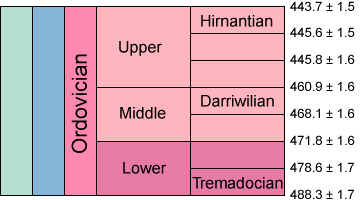Ordovician: Ancient Oceans Separate the Continents

The Ordovician period began approximately 510 million years ago, with the end of the Cambrian, and ended around 445 million years ago, with the beginning of the Silurian. At this time, the area north of the tropics was almost entirely ocean, and most of the world's land was collected into the southern super-continent Gondwana. Throughout the Ordovician, Gondwana shifted towards the South Pole and much of it was submerged underwater.
 The Ordovician is best known for the presence of its diverse marine invertebrates, including graptolites, trilobites, brachiopods, and the conodonts (early vertebrates). A typical marine community consisted of these animals, plus red and green algae, primitive fish, cephalopods, corals, crinoids, and gastropods. More recently, there has been found evidence of tetrahedral spores that are similar to those of primitive land plants, suggesting that plants invaded the land at this time.
The Ordovician is best known for the presence of its diverse marine invertebrates, including graptolites, trilobites, brachiopods, and the conodonts (early vertebrates). A typical marine community consisted of these animals, plus red and green algae, primitive fish, cephalopods, corals, crinoids, and gastropods. More recently, there has been found evidence of tetrahedral spores that are similar to those of primitive land plants, suggesting that plants invaded the land at this time.
From the Early to Middle Ordovician, the earth experienced a milder climate in which the weather was warm and the atmosphere contained a lot of moisture. However, when Gondwana finally settled on the South Pole during the Late Ordovician, massive glaciers formed causing shallow seas to drain and sea levels to drop. This likely caused the mass extinctions that characterize the end of the Ordovician, in which 60% of all marine invertebrate genera and 25% of all families went extinct.
During the Ordovician ancient oceans separated the barren continents of Laurentia, Baltica, Siberia and Gondwana. The end of the Ordovician was one of the coldest times in Earth history. Ice covered much of the southern region of Gondwana.
Panotia, the super-continent that formed at the end of the Precambrian Era, approximately 600 million years ago, had already begun to break apart by the beginning of the Paleozoic Era. A new ocean, the Iapetus Ocean, widened between the ancient continents of Laurentia (North America), Baltica (Northern Europe), and Siberia.
Gondwana, the super-continent that was assembled during the Pan-African orogeny, was the largest continent at this time, stretching from the Equator to the South Pole.
During the Ordovician Period, warm water deposits, such as limestone and salt, were found in the equatorial regions of Gondwana (Australia, India, China, and Antarctica), while glacial deposits and ice-rafted debris occurred in the south polar areas of Gondwana (Africa and South America).
Please click here to complete it